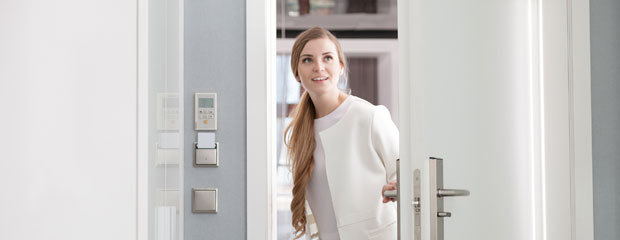The adoption of contactless hotel technologies, especially guest self-check-in, has established a strong foothold across market segments since COVID hit. According to 2020 research by hotel guest engagement platform Criton, 80% of hotel customers would download a hotel app that would enable them to check in, check out and get hotel information. Evidently, guest demand for self-check-in is high, which makes sense during the pandemic and also beyond due to substantial benefits to guest engagement and front desk operations. While modern hotel management software makes implementing contactless check-in easy (with or without an app), there are important factors to consider to ensure a seamless and safe self-check-in experience for your guests and your property.
Let guests know you offer contactless check-in
For most guests, contactless check-in is a selling point when choosing a hotel, but some prefer to register with front desk staff upon arrival. Either way, letting guests know in advance that your property offers contactless check-in is key to boosting bookings and helping guests feel confident about the self-check-in process.
Promote your property’s contactless check-in experience on your hotel website, complete with a step-by-step overview of the process, so potential guests understand how convenient it is. Make sure everyone gets the message by advertising contactless check-in on your property’s social media channels and in OTA listings, your digital newsletter and email campaigns, and booking confirmations too.
Make sure you get the information you need
In order to achieve a seamless contactless check-in experience, hotels need consistent, accurate guest data. For a start, a mobile self-check-in process requires the guest’s mobile phone number and/or email address for communicating check-in instructions and delivering the mobile key or key code to the guest.
Making mobile phone and email fields compulsory on the booking form—both for bookings entered by front desk agents and bookings made by guests online—ensures this vital data is saved to reservations and guest profiles in the property management system (PMS) from where it is pulled when pre-arrival communications are sent.
When creating group bookings, try to obtain contact information for each separate reservation within the group instead of using the group contact person’s information for all reservations, so that every guest within the group can receive check-in information directly.
Determine payment and identity verification requirements
Defining payment and identity verification requirements for self-check-in helps prevent security issues and administrative headaches. Will online self-check-in be reserved for guests who booked direct or repeat guests only, or will it be available to all guests? Limiting self-check-in to established guests can help lower the risk of fraud. Such a decision will be impacted by your property’s policies and operational systems, for example, whether or not your property receives guest contact information for OTA bookings prior to arrival.
Requiring guests to submit a photo of their credit card and/or photo ID when checking in online helps protect your customers from credit card fraud and identity theft, while requiring credit card information or payment for online check-in protects your business from revenue loss. You can configure your online check-in form to require this information. If your property requires payment as part of the online check-in process, ensure a secure payment environment with a PCI-compliant payment gateway integration.
Send check-in instructions at the right time
Contactless check-in fails miserably when check-in communications are not delivered to guests in time for their arrival! This can result in guest dissatisfaction and confusion, especially if they expected to check themselves in. Automating self-check-in messaging through your PMS is key to ensuring every guest knows what to expect and feels confident about the check-in process.
A pre-check-in email or text message outlining your property’s contactless check-in procedure should be sent the day before arrival or the morning of the check-in date,* and should include a link to an online check-in or registration form for the guest to submit the required information (including payment information and photo ID) and agree to the terms and conditions of their stay.
Once the guest has completed their online registration, a message confirming their check-in has been approved should be sent to the guest, and should include step-by-step instructions for accessing their room upon arrival, including the room number, key code or digital key download instructions (or where to pick up their physical room key), where to park and any other pertinent information such as your property’s COVID protocols.
Customizable email templates for online registration and check-in approval can be set up to automatically pull reservation data to ensure accurate, personalized communications are sent to every guest. Ensure communications are sent on time by triggering messages based on the reservation check-in date and time, whether communications are sent directly from your PMS or from a third-party contactless check-in app integrated with your PMS.
*If payment is required when a guest checks in online, message delivery should also be timed to align with your property’s deposit/payment policy to ensure automatic payments are taken correctly. For example, if the payment policy attached to the booking is set up to require payment on the day of arrival, the online check-in form should be sent to the guest on the check-in date and not before. Otherwise, if the guest checks in online prior to their arrival date, the system would not yet recognize a payment owing on the reservation and the guest could complete check-in without paying.
On-site best practices
Support online check-in with on-site guidance for arriving guests. Plenty of signage in the lobby clearly outlining self-check-in directions, including room and facility directions, helps guests understand where to go and what to do and is key to a stress-free arrival. It’s also important for hotel staff to be available to welcome guests and assist them with check-in when needed or if preferred by the guest.
If guests are new to contactless check-in at your property, the potential for confusion is higher. Providing clear on-property directions and being available to answer guests’ questions helps to ensure that every guest has a smooth check-in experience.
Implementing contactless check-in is easier than you think, but it’s important to consider every step of the self-check-in process and how it will work for your property in order to ensure a seamless experience for guests and maximum efficiency for staff.
WebRezPro PMS supports contactless check-in best practices to provide a safe and efficient self-check-in experience using our inbuilt guest agreements feature or direct integration with third-party mobile check-in applications. As we begin 2022, contactless check-in is fast becoming a standard guest expectation, so why wait? If you’re managing daily operations with a cloud PMS like WebRezPro, the tools for implementing online check-in are already in your hands.


